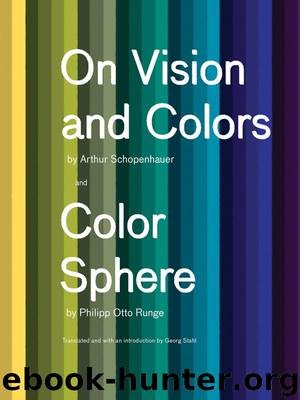On Vision and Colors by Georg Stahl

Author:Georg Stahl
Language: eng
Format: epub
Publisher: Princeton Architectural Press
Published: 2011-03-31T16:00:00+00:00
The diagram shows in more detail how the four prismatic colors (not seven), that only really exist, emerge from the effect of the two secondary images that come about through prismatic refraction in accordance with Goethe’s fundamental law.
The diagram represents a white paper disc about four inches in diameter, glued on matte black paper, as it appears naturally when seen through a prism at a distance of about three feet and not in accordance with Newtonian fictions. Everybody who wants to know what it is about must convince himself by observation. By holding the prism before our eyes and stepping backward and forward, we will see almost immediately both secondary images, and by following its movements, how they deviate from the main image and shift over each other. If we step considerably farther back, then blue and yellow overlap each other, and we enjoy the highly edifying spectacle of seeing Newton’s homogeneous green light, the pure primary green, being composed. Prismatic experiments can be carried out generally in two ways: either by showing that refraction precedes reflection, or that reflection precedes refraction. The former happens when the sun’s image passes through a prism and falls on a wall, the latter when we observe a white image through a prism. The latter method is not only less troublesome to carry out, but also shows the actual phenomenon more clearly. This is partly due to the fact that the effect of the refraction reaches the eye directly, whereby we have the advantage of receiving it firsthand, whereas with the other method we receive the effect secondhand, after reflection from the wall. This is so partly also because the light comes directly from an adjacent, sharply outlined, and not dazzling object, whereas with the first method, it is the image of a body 20 million miles away, correspondingly large, and radiating its own light, that passes through the prism. Therefore, the white disc shown here (its position represents the sun with the first method) shows quite clearly the two secondary images accompanying the main image, that have come about through a double refraction displacing it upwards. The secondary image caused by the first refraction, which occurs when light enters the prism, trails behind and remains for that reason with its outermost edge stuck in the darkness and covered over by it. The other secondary image, which results from the second refraction, when the light emerges from the prism, rushes forward and therefore pulls over the darkness. The effect of both also extends, although more faintly, to that part of the main image that is weakened by their loss. Therefore, only that part of it appears white which remains covered by both secondary images, and thus retains its full light. On the other hand, where one secondary image struggles alone with darkness, or where the somewhat weakened main image is already impaired by darkness through dissipation of the secondary, colors come into being, and moreover in accordance with Goethe’s law. Consequently, we see violet
Download
This site does not store any files on its server. We only index and link to content provided by other sites. Please contact the content providers to delete copyright contents if any and email us, we'll remove relevant links or contents immediately.
Make Comics Like the Pros by Greg Pak(2852)
Draw-A-Saurus by James Silvani(2655)
Modern Cartooning by Christopher Hart(2557)
Manga Workshop Characters by Sophie Chan(1912)
Manga Crash Course Fantasy by Mina Petrovic(1893)
Creative Character Design by Bryan Tillman(1888)
The Absolutely True Diary of a Part-Time Indian by Sherman Alexie(1858)
How To Draw Caricatures by Lenn Redman(1614)
Freehand Figure Drawing for Illustrators by David H. Ross(1586)
How to Draw a Character by Soizic Mouton(1585)
Learn to Draw Action Heroes by Robert Marzullo(1554)
The DC Comics Guide to Coloring and Lettering Comics by Mark Chiarello(1544)
How to Draw an Object by Soizic Mouton(1544)
Supergods by Grant Morrison(1538)
Stan Lee's How to Draw Comics by Stan Lee(1532)
The DC Comics Guide to Writing Comics by Dennis O'Neil(1509)
ANIME Drawing BOX set 5-in-1: Anime Drawing for Beginners, Drawing Anime Faces, Drawing Anime Emotions, Manga Drawing for Beginners, Anime Drawing Practical Guide by Li Shen & Jane Mackle & Yuka Hiramatsu(1430)
Secret Teachings of a Comic Book Master by Heidi MacDonald(1372)
American Political Cartoons by Stephen Hess & Sandy Northrop(1310)
